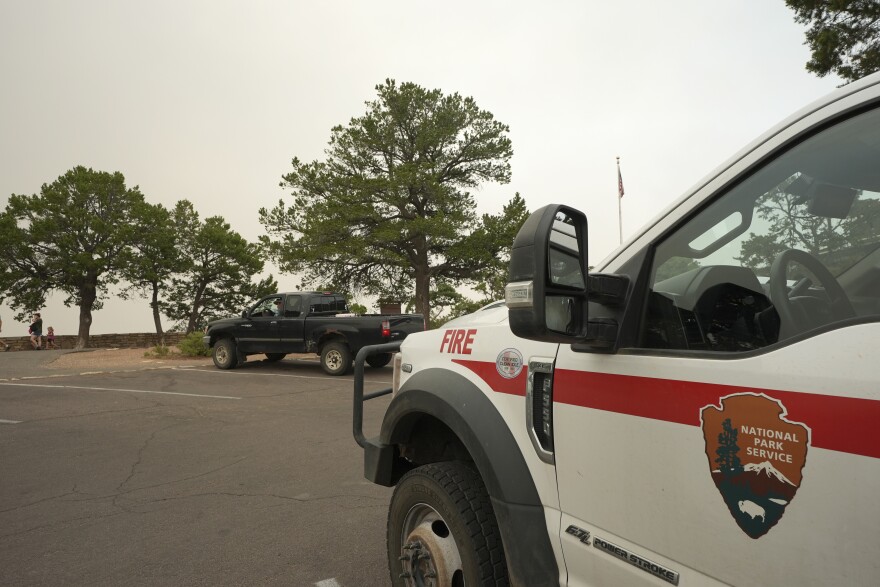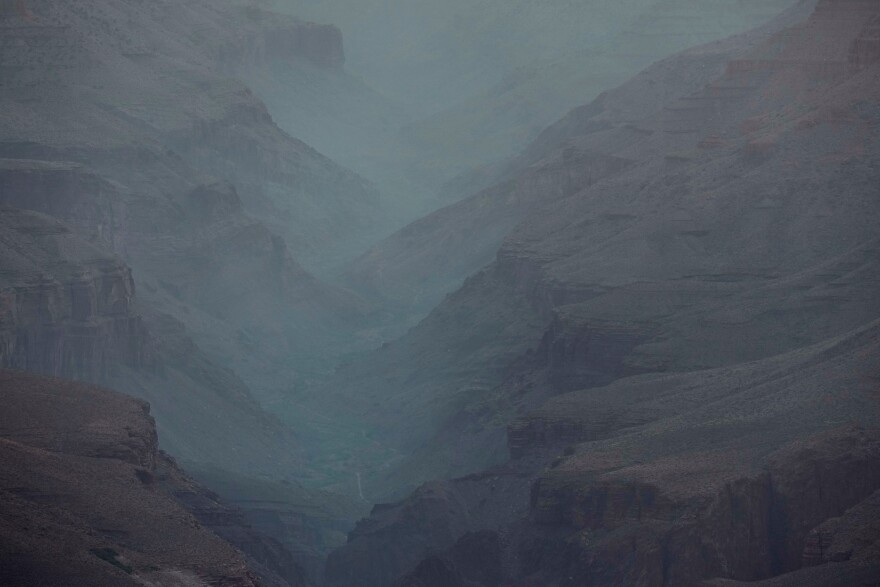The National Park Service is defending its handling of a lightning-sparked wildfire that destroyed the nearly century-old Grand Canyon Lodge and dozens of historic cabins, saying containment lines had been built around the blaze and crews were prepared to conduct defensive firing operations.
But then came a sudden and extreme shift in the wind that far exceeded forecast conditions, the agency recounted Tuesday in an email sent to The Associated Press.
"The Dragon Bravo Fire began July 4 as a lightning-caused wildfire and was under a full suppression strategy from the outset," the agency said, adding that the team first assigned to the fire "effectively managed the fire through its initial phase" and that Grand Canyon National Park requested additional resources as fire activity increased.
The Park Service had posted on social media last week that the fire was being managed under a "confine and contain strategy," which allowed for the natural role of fire on the landscape while minimizing the risk to infrastructure and other values.
Arizona's governor and members of the state's congressional delegation called for an investigation as the Park Service immediately came under scrutiny after the lodge and other historic buildings were destroyed.

The flames were fanned by uncharacteristic nighttime gusts that topped 40 mph, said fire information officer Stefan La-Sky.
"Normally, the fire 'lays down' at night because of higher humidity and lower temperatures, but this thing was really wind-driven," La-Sky said Tuesday, adding that it is extremely dry across the region.
The weather was more favorable Tuesday as hundreds of firefighters worked to stop the Dragon Bravo Fire from consuming any more of the buildings along the park's less-visited North Rim, including a water pumping station that supplies the South Rim, La-Sky said.
A separate blaze dubbed the White Sage Fire was burning further north. Together, the two fires have charred more than 90 square miles. That is more than twice the size of the entire Walt Disney World complex in Florida.
Tourists watch smoke rise
Tourists standing along the park's popular South Rim on Tuesday watched plumes of smoke rise above the sweeping vista, filling the canyon with a thick haze and pooling in its depths.
"By the afternoon, it was completely socked in," Christi Anderson said of the smoke that had filled the canyon the day before. "You couldn't see anything, none of that. It was crazy."
Anderson was visiting from California and considered herself lucky because she had shifted her reservation to the South Rim in the preceding days. Otherwise, she would have been among those forced to evacuate.
Park officials have closed access to the North Rim, a more isolated area that draws only about 10% of the Grand Canyon's millions of annual visitors. The park spans more than 1,900 square miles.

Neither blaze had any containment, and La-Sky said it was too early for his team to offer a timeline.
"We're always at the mercy of Mother Nature," he said.
Complex fire management program
Over the years, managers at the Grand Canyon have successfully used fire to benefit the landscape, with the park having what some experts say is an exemplary fire management program that has tapped both prescribed fire and wildfires to improve forest health.

Andi Thode, a professor of fire ecology and management at Northern Arizona University and the lead at the Southwest Fire Science Consortium, said park managers have even re-burned some areas in multiple places over the years to create what she called "one of the best jigsaw puzzles" on public land. She noted that fire behavior decreased significantly when the Dragon Bravo Fire burned into the footprint of a previously burned area.
"So creating that heterogeneity across the landscape, using fire is a really critical tool moving forward to be able to help in the future with these wildfire events that are happening at the worst time in the worst weather conditions with the driest fuels," Thode said.
The park's 2025 fire management plan notes the Grand Canyon's designation as a World Heritage Site, referencing cultural and natural resources, spiritual and inspirational qualities, recreational opportunities and other values.
"It is the Fire Management Program's mission to manage wildland fires to preserve, enhance and (where necessary) restore these values," the plan reads.
Those areas that have the most infrastructure and are among the most highly used by the public make up just over 1% of the park. According to the plan, managing wildfires for resource benefit objectives within these areas is not permitted and that the overall intent within these areas is to "protect life and property in its natural setting."
The fire exclusion areas listed in the plan include the developed area of the North Rim.
Aside from outlining policies for responding to wildfires and planning for prescribed fires, the document includes links to tools that fire managers can use for assessing risk. The lodge and surrounding cabins were among the more than 370 structures at the park that were considered high risk. Another 238 structures fall in the moderate risk category.
The Park Service reiterated Tuesday that the safety of the public and firefighters come first.
"Firefighters are continuing to respond to this fire in the safest way possible putting their lives and the lives of the community, park visitors, and park employees ahead of buildings." the agency said.
___
Montoya Bryan reported from Albuquerque, New Mexico, and Seewer reported from Toledo, Ohio. Associated Press writers Christopher Keller in Albuquerque, New Mexico, and Safiyah Riddle in Montgomery, Alabama, contributed to this report.


